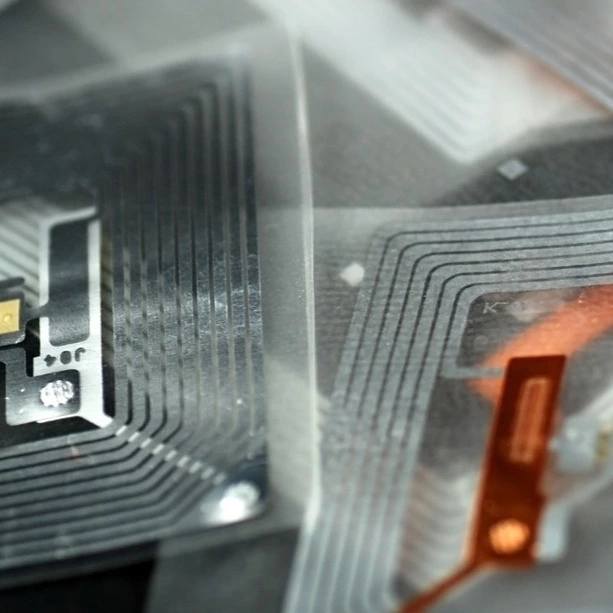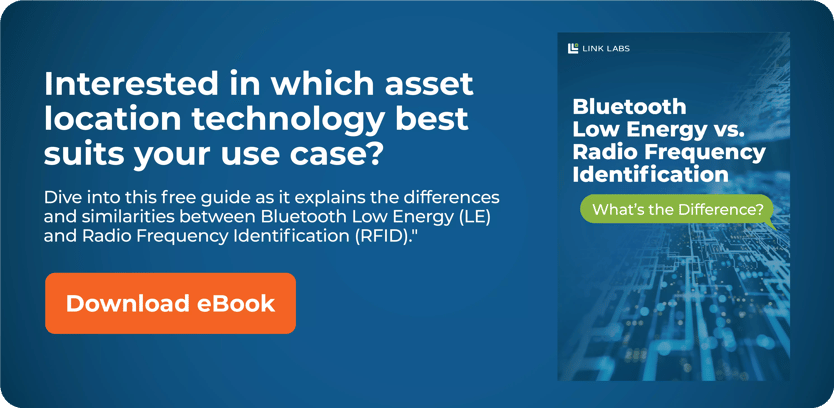If you’re searching for asset location technology, you may be trying to clear up the difference and similarities between Bluetooth Low Energy (BLE) and radio-frequency identification (RFID). It’s important to first brush up on the descriptions of a few commonly-confused real-time location system (RTLS) solutions:
- Bluetooth Low Energy (BLE) vs. RFID: Two different types of radio systems used, among other things, for asset location services.
- Active RFID vs. passive RFID: Active RFID systems (otherwise known as active RTLS) are battery-powered sensors that connect to various access points throughout an area (like a building) and transfer data to the cloud. Passive RFID, on the other hand, is what you most often think of as RFID. This technology uses a high-power, low-frequency actuator to radiate toward a tag. The tag absorbs the energy and radiates back at a higher frequency and lower power.
- RFID vs. iBeacon: iBeacons are a type of active RFID that use BLE.
Below, we’ll walk through the benefits and considerations of both BLE and RFID as well as use cases you’d most likely see for each.
Passive RFID Asset Tracking
Passive RFID is the type of technology you’ve likely seen in libraries and retail stores. This system uses simple, battery-free tags and high-power readers. These are often used for tracking assets through a chokepoint and for anti-theft efforts.
Benefits Of Passive RFID
- Passive RFID sticker tags, when purchased in bulk, can cost only a few pennies a piece.
- Passive RFID tags don’t run on battery, so they essentially last forever (which is a clear benefit).
- The accuracy of location for passive RFID is pretty high because the range is so limited. In other words, since you can only read tags one meter away, you know with decent certainty the tag is there.
Things To Consider
- While the tags for passive RFID are inexpensive, the readers are very expensive. And unless you’re using chokepoint RFID (which is what storefronts with large resonators use), you will need a lot of them for asset location tracking. In fact, you would need to position these readers every 10-15 feet for them to work as a real-time location system (RTLS).
- To work properly, passive RFID readers radiate a great deal of energy to pick up tag signals. Some organizations (such as hospitals) may be wary of this.
Bluetooth Low Energy Asset Tracking (Active RFID)
BLE (or active RFID) systems operate by a tag “beaconing,” or sending out transmission, to a reader, and then transmitting that location to the cloud. iBeacons are a type of active RFID that use BLE.
Benefits Of BLE
- There’s often no IT integration (depending on the solution).
- Top to bottom, this is the least expensive RTLS option.
- You don’t have to cover the entire area you’d eventually like to deploy in. You can start in one area, or with one function, and create value before scaling. This “crawl, walk, run” approach with testing and deploying isn’t available with most RTLS solutions.
Things To Consider
- Location accuracy of active RFID is only as granular as the number of readers you have, so many readers are necessary for a high level of accuracy. Potential users must consider that there is a major cost trade-off between the pinpoint accuracy of ultra wide-band and the room-level accuracy of active RTLS.
- Compared to passive RFID, the battery life of BLE systems isn’t as ideal. But it’s important to consider your use case here. Many devices have a battery life of five or more years, and the tracking lifetime for that particular object is often less than that.
- BLE can also be prone to some interference from other devices, as is the case with any radio system. From a security perspective, there’s no way to get into a data system over the air, so this isn’t much of a concern with BLE.
Use Cases: BLE Vs. RFID
Once you understand the BLE vs. RFID differences, you likely understand which solution is best for your use case.
Passive RFID
- If low-cost tags are extremely important, passive RFID will always win. You’re never going to make a BLE tag for less than $2, whereas passive tags can cost pennies in high volume.
- If you want to track assets as they move through a chokepoint, passive RFID is ideal. It acts as a point-of-presence scan in a number of situations. For example, shipping organizations may use RFID tags to make scanning both faster and easier through a conveyer belt. Airlines may put RFID stickers into luggage tags so passenger bags don’t need to be scanned with a barcode reader.
- If you want to gain discreet point-of-retail tracking capabilities, passive RTLS may work well for you. Many OEMs will pay retailers to place RFID scanners on their product shelf so they know exactly how many of their widgets are sold.
BLE (Active RFID)
- If your goal is to make compliance easier and more streamlined, BLE may be your best bet. For instance, you can use an active RFID system to track and report equipment that is shipped to or from your building for reporting purposes.
- If you need to get a handle on quality control, BLE is ideal. You can use an active Bluetooth-based RFID system to, say, track pallets to ensure all of your fresh produce leaves the plant on schedule.
- If you want to monitor visitors or vendors on your property or job site, look into a BLE system. You can integrate active RFID into an ID or visitor badge and help mitigate any potentially harmful or hazardous situations.
In Summary
Be sure not to discount any technologies without fully understanding the benefits, tradeoffs, and what you need to track. And if you have any questions about BLE vs. RFID, feel free to reach out to us.




